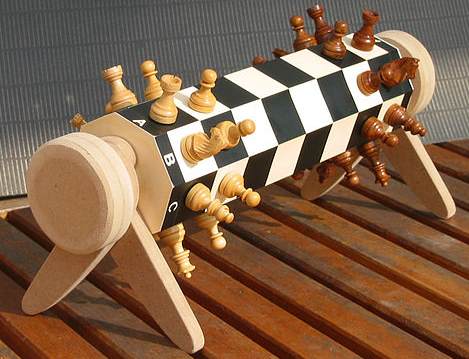Cylindrical Chess

Cylindrical Chess, also called Cylinder Chess, has been around since at least the early 19th century and possibly much longer. According to researcher Bill Wall, a cylindrical variant was mentioned (along with five other variants) in a book dated to 947 AD called Muraj adh-dhahab (Fields of Gold).[1] In issue 22 of Variant Chess magazine, however, it is stated that the game described in this manuscript was actually the circular board of Byzantine Chess. Pritchard notes in The Encyclopedia of Chess Variants that the Marquis Teodoro Ciccolini played on a cylindrical board in the early 1800s and A. Piccinini used it as a theme for Chess problems starting in 1907.
Setup
Cylindrical Chess has the same setup as Chess and is normally played with the same equipment. However, each rank is understood to loop back to the other side, as though the board were wrapped around a cylinder, as shown in the photo at the top. This allows horizontal movement to continue on the other side of the board. Playing on an actual cylindrical surface is impractical, though you may try playing it this way with Cylinder Chess on Jocly. In light of this, it is usually played on a flat surface. This is usually the regular Chess board, as that is what is most commonly available, but it can also be played on a round board, as depicted below:

It may also be played on a spherical board or its flat representation of two circular hemispheres, as shown on our Spherical Chess page. In 1976, Mark Davis reinvented Cylindrical Chess in both forms, calling one Round Chess and the other Spherical Chess.
If you have JavaScript enabled, you will see an interactive diagram for this game on the usual Chess board. You can use this diagram to see how pieces would be able to move from some side positions, which were chosen to highlight how pieces move differently in this game than in Chess.
Rules
The game uses the same rules and pieces as regular Chess but the left and right edges of the board are considered to be connected, so if a piece moves off one side, it emerges on the other. The diagrams below show examples.
He can capture the Knight on d7. |
Castling: Typically, the wrap-around board is the only modification to the rules of Chess, although some players eliminate the castling rule. Castling is usually seen as serving two purposes: connecting the Rooks and moving the King towards safety in the corner. On the cylindrical board, however, the Rooks are already "connected" at the beginning of the game, and there are no corners in which to hide. Other players, however, such as those in the now-defunct NOST, expanded castling by allowing the King to castle with a Rook across the board edge (King castles with the a1 Rook by moving to g1 and the Rook moving to f1, or the King castles with the h1 Rook by moving to c1 and the Rook moving to d1.) Unless specifically agreed to by the players, however, the default rule for Cylindrical Chess is that castling remains unchanged from orthodox Chess.
Null move: It is forbidden to make a move that does not change the position. A Rook on an empty rank could theoritically zoom across the edges and back to the starting square resulting in a "null move". This is typically not allowed, although T. R. Dawson, writing in Problemist Fairy Chess Supplement in December 1931, stated that he felt the null move should be allowed and called this the sigle most interesting novelty of the game. By agreement, players may allow a null move if they wish, but by default it is disallowed.
Strategy
All pieces are more mobile on the cylindrical board but the Bishops benefit the most. In Chess, a Rook always attacks 14 squares from any position on an empty board, but a Bishop attacks at most 13 and as little as 7 depending on location. On the cylindrical board, however, both pieces always attack 14 squares on an empty board from any location. Bishops are still colorbound, although interestingly, on a cylindrical board with an odd number of files they no longer would be. And the enhanced Bishop-move means the Queens are even more deadly. As a final note on the Bishop, the two diagonal lines either forward or backward converge at a point (4, 4) spaces away, making it possible to issue double check with a single piece. In the first diagram, the Bishop attacks the b5 square by two different paths.
H. G. Muller has estimated the values of the pieces to be as follows: Pawn 1, Knight 3.25, Bishop 4, Rook 5, Queen 11.
Other considerations include the fact that the concept of centralization completely changes. Instead of being a square-shaped region in the center of the board, the "center" is now a stripe of two ranks across the board. Since the center is larger, the ability to control it is greatly reduced. The value of having a Knight outpost, for example, is probably diminished. Also, there are no longer any edge pawns. An a-pawn can be connected with an f-pawn.
Finally, it requires more material to win an endgame. A Rook is no longer sufficient to win against a bare King because the King cannot be trapped in a corner. A Queen, however, can still mate, as can a pair of Bishops. In fact, Bishops are so strong on this board that a pair of Bishops can still win even if the opponent has a Knight.
Cylindrical Chess problems
Web page rewritten: 2019-05-25 by Greg Strong. Original page here.
